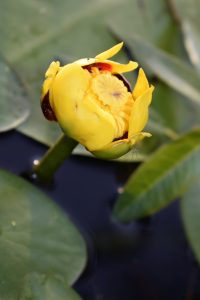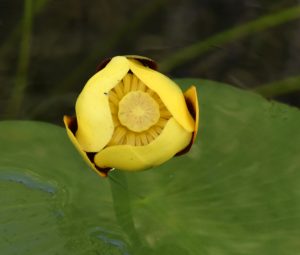Yellow Pond-lily
 Nuphar varigata, also known as the bullhead lily, is an aquatic species found in the same niche as American white water lily. Like many water lilies (and lotus flowers) they use the entrapment method for pollination. When flowers open on the first day, the stamen are not yet producing pollen, while the female parts are receptive and ready. Pollinators — commonly beetles and flies — will visit the flower and become trapped when the flower closes for the night because the unwitting pollinators frequently fall into the pool at the bottom of the flower’s cup, and cannot always get out right away. In the process of struggling, pollen from a recently visited lily washes off their body with plenty of time to fertilize the flower. On the second day, the flower opens with its male parts ripened and producing pollen. Hopefully, the trapped pollinator survives the night and is released. As the pollinator leaves the flower, it becomes covered in that flower’s pollen which it can transport to the next flower, thus continuing the cycle.
Nuphar varigata, also known as the bullhead lily, is an aquatic species found in the same niche as American white water lily. Like many water lilies (and lotus flowers) they use the entrapment method for pollination. When flowers open on the first day, the stamen are not yet producing pollen, while the female parts are receptive and ready. Pollinators — commonly beetles and flies — will visit the flower and become trapped when the flower closes for the night because the unwitting pollinators frequently fall into the pool at the bottom of the flower’s cup, and cannot always get out right away. In the process of struggling, pollen from a recently visited lily washes off their body with plenty of time to fertilize the flower. On the second day, the flower opens with its male parts ripened and producing pollen. Hopefully, the trapped pollinator survives the night and is released. As the pollinator leaves the flower, it becomes covered in that flower’s pollen which it can transport to the next flower, thus continuing the cycle.
Yellow Pond-lily provides food and shelter for fish, snails, crayfish, and underwater insects, some of the latter who rely on this plant for their entire life cycle. This sort of specialization between insect and plant species is not unusual, and involves both symbiotic and parasitic relationships. Muskrats and waterfowl also enjoy eating the fruits.
 Tribal Nation traditions involve using this plant both medicinally and as a food source. For a traditional cuisine, boil and roast the tubers and prepare the seeds like popcorn.
Tribal Nation traditions involve using this plant both medicinally and as a food source. For a traditional cuisine, boil and roast the tubers and prepare the seeds like popcorn.
